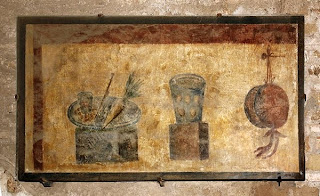Houses in Longanikos
"In summary, architectural labor from the 18th to the early 20th century was organized in itinerant groups of masons. They would specialize on the finer aspects of construction, such as the corners, quoins, the windows, openings and roofing and would hire local work for the unspecialized work, such as building infill walls." Such construction is shown in the next pictures.
Main street through Longanikos
Stones were secured with iron clamps, and each group signed its work with its own design of clamp. You can see at least 8 of them around the large doorway -- click to enlarge -- in the photograph at the top, and at least 6 around the smaller. Similarly, you can find at least 8 clamps for the left-hand doorway in Leondari and 10 for the second.
Tegea
Tegea
All the other towns here are mountain towns. Mountains are made of stone. Tegea is on flat, damp land. These Tegea houses were immediately around the remains of the temple of Athena Alea and were built of its stones. I was there two years ago with a learned group, and there was an interminably long lecture about the remaining stones of the temple. No one seemed to care, or even notice, all the stone houses -- with their spolia. Tegea houses are plumped full of spolia, like puddings with raisins.
Apparently a great deal has been written about these clamps, and many photographs taken, but they were new to me.
South of Leondari
Ag. Nicholaos, Karitena
Dimitsana
Dimitsana bell tower
Dimitsana
I like these continuities: so much of Greek history has been discontinuous. In 1480 and 1480 when Bartolomeo Minio was rebuilding the walls of Nauplion, he could find no one who knew how to build in stone. He had to have five masons and a master-builder sent out from Venice. Travelers write about the shabbiness of Venetian towns in Greece and their proneness to fire. I found good evidence that Venetian houses were for the most part wooden, at least above the ground floor, and standardized sizes of planks and nails were shipped out from Venice for their construction.
There was no Morea-made iron in the 15th century. Minio had to order clamps -- and nails, and anything of iron -- ready-made from Venice, again in standardized sizes. Already before 1420, Plethon had worried to Manuel II and Theodoros II about the lack of local skills and Moreote dependence on foreign imports, In the 1440s, Bessarion wrote Constantine, concerned about the lack of Greek skills -- iron-working was one he particularly mentioned, along with ship-building and weaponry -- and suggested that eight young men be sent to Italy to learn. More on that later.
Diana Gilliland Wright, “The Wooden Towns of the Stato Mar: Medieval Construction in Nauplion,”
Studi Veneziani 40 (2000) 169-178.

















